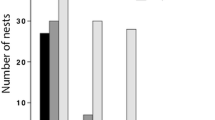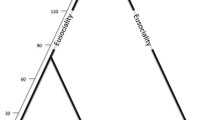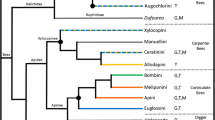Summary
Halictine bees exhibit an enormous diversity of solitary and social colony structures. To investigate social evolution in the genusHalictus, phylogenies of 15 species of the subgeneraH. (Halictus) andH. (Seladonia) were constructed based on protein electrophoretic data. Solitary, social, and socially polymorphic species were included.Halictus (Seladonia) apparently rendersH. (Halictus) paraphyletic. The common ancestor ofH. (Halictus) andH. (Seladonia) was probably social or socially polymorphic. This implies that some solitary and socially polymorphic species, such asH. confusus andH. tumulorum, represent evolutionary reversals from a completely eusocial condition to the solitary condition that is thought to be primitive for the subfamily as a whole.
Similar content being viewed by others
References
Abrams, J. and G. C. Eickwort, 1981. Nest switching and guarding by the communal sweat beeAgapostemon virescens (Hymenoptera, Halictidae).Ins. Soc. 28: 105–116.
Batra, S. W. T., 1966. Nests and social behavior of halictine bees of India (Hymenoptera: Halictidae).Ind. J. Entomol. 28: 375–393.
Blüthgen, P., 1961. Ergebnisse der Deutschen Afghanistan-Expedition 1956 der Landessammlungen für Naturkunde Karlsruhe. Diploptera and Apoidea (partim) (Hymenoptera). Beitr. Naturk. Forsch. SW-Deutschl. 19: 277–287.
Bonelli, B., 1967. Osservasioni biologiche sugli imenotteri melliferi e predatori della Val di Fiemme. XXIII.Halictus rubicundus CHRIST. (Hymenoptera-Halictidae).Stud. Trent. Sci. Nat. B. 44: 85–96.
Buth, D. G., 1984. The application of electrophoretic data in systematic studies.Ann. Rev. Ecol. Syst. 15: 501–522.
Carpenter, J. M., 1988. Choosing among multiple equally parsimonious cladograms.Cladistics 4: 291–296.
Carpenter, J. M., 1989. Testing scenarios: Wasp social behavior.Cladistics 5: 131–144.
Carpenter, J. M., 1991. Phylogenetic relationships and the origin of social behaviour in the Vespidae. In:The Social Biology of Wasps (K. G. Ross and R. W. Matthews, Eds.), Cornell University Press, Ithaca, New York, pp. 7–32.
Chandler, L., 1955.The ecological life history of Halictus (H.) ligatus Say with notes on related species. Unpub. PhD thesis, Purdue University, Michigan.
Coddington, J. A., 1988. Cladistic tests of adaptational hypotheses.Cladistics 4: 3–22.
Eickwort, G. C., 1985. The nesting biology of the sweat beeHalictus farinosus in California with notes onH. ligatus (Hymenoptera, Halictidae).Pan-Pac. Entomol. 61: 122–137.
Farris, J. S., 1988. Hennig: Hennig86 reference, version 1.5.
Knerer, G., 1980. Biologie und Sozialverhalten von Bienenarten der GattungHalictus Latreille (Hymenoptera, Halictidae).Zool. Jb. Syst. 107: 511–536.
Michener, C. D., 1974.The Social Behavior of the Bees. Belknap Press, Cambridge.
Michener, C. D., 1978. The classification of halictine bees: Tribes and old world nonparasitic genera with strong venation.Univ. Kansas Sci. Bull. 51: 501–538.
Mickevich, M. F. and C. Mitter, 1981. Treating polymorphic characters in systematics: A phylogenetic treatment of electrophoretic data. In:Advances in Cladistics (V. A. Funk and D. R. Brooks, Eds.), New York Botanical Garden, New York, pp. 45–58.
Packer, L., 1986. The social organisation ofHalictus ligatus (Hymenoptera; Halictidae) in southern Ontario.Can. J. Zool. 64: 2317–2324.
Packer, L., 1990. Solitary and eusocial nests in a population ofAugochlorella striata (Provancher) (Hymenoptera; Halictidae) at the northern edge of its range.Behav. Ecol. Sociobiol. 27: 339–344.
Packer, L., 1991. The evolution of social behavior and nest architecture in sweat bees of the subgenusEvylaeus (Hymenoptera: Halictidae): a phylogenetic approach.Behav. Ecol. Sociobiol. 29: 153–160.
Packer, L. and R. E. Owen, 1989. Allozyme variation inHalictus rubicundus (Christ): A primitively eusocial halictine bee (Hymenoptera: Halictidae).Can. Entomol. 121: 431–438.
Packer, L. and R. E. Owen, 1992. Variable enzyme systems in the Hymenoptera.Biochem. Syst. Ecol. 20: 1–7.
Pesenko, Y. A., 1985. A subgeneric classification of bees of the genusHalictus Latreillesensu stricto (Hymenoptera; Halictidae).Entomol. Rev. 63: 1–20.
Roberts, R. B. and R. W. Brooks, 1987. Agapostemonine bees of Mesoamerica (Hymenoptera: Halictidae). Univ. Kans. Sci. Bull. 53: 357–392.
Sakagami, S. F., 1974. Sozialstruktur und Polymorphismus bei Furchen- und Schmalbienen (Halictinae). In:Sozialpolymorphismus bei Insekten. Probleme der Kastenbildung in Tierrich (G. H. Schmidt, ed.), Wiss. Verlagsgesellschaft, Stuttgart, pp. 257–293.
Sakagami, S. F., 1980. Bionomics of the halictine bees in northern Japan. I.Halictus (Halictus) tsingtouensis (Hymenoptera, Halictidae) with notes on the number of origins of eusociality.Kontyu 48: 526–536.
Sakagami, S. F. and P. A. W. Ebmer, 1979. Halictus(Seladonia) tumulorum higashi ssp. nov. from the Northeastern Palaeartic (Hymenoptera: Apoidea: Halictidae).Kontyu 47: 543–549.
Sakagami, S. F. and K. Fukushima, 1961. Female dimorphism in a social halictine bee,Halictus (Seladonia) aerarius (Smith).Jap. J. Ecol. 11: 118–124.
Sakagami, S. F. and M. Munakata, 1972. Distribution and bionomics of a transpalaeartic eusocial halictine bee,Lasioglossum (Evylaeus) calceatum, in northern Japan, with reference to its solitary life cycle at high altitude.J. Fac. Sci. Hokkaido Univ. Ser. 6 (Zool.) 18: 411–439.
Sanderson, M. J. and M. J. Donoghue. 1989. Patterns of variation in homoplasy.Evolution 43: 1781–1795.
Wiley, E. O., D. Siegel-Causey, D. R. Brooks and V. A. Funk, 1991.The Compleat Cladist: A Primer of Phylogenetic Procedures. Univ. Kans. Mus. Nat. Hist. Spec. Publ. 19, 158 pp.
Author information
Authors and Affiliations
Rights and permissions
About this article
Cite this article
Richards, M.H. Social evolution in the genusHalictus: a phylogenetic approach. Ins. Soc 41, 315–325 (1994). https://doi.org/10.1007/BF01242303
Received:
Revised:
Accepted:
Issue Date:
DOI: https://doi.org/10.1007/BF01242303




